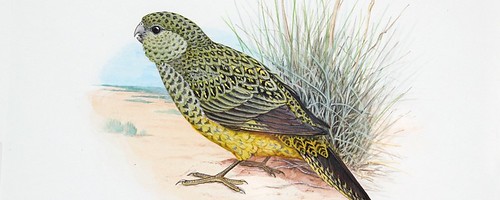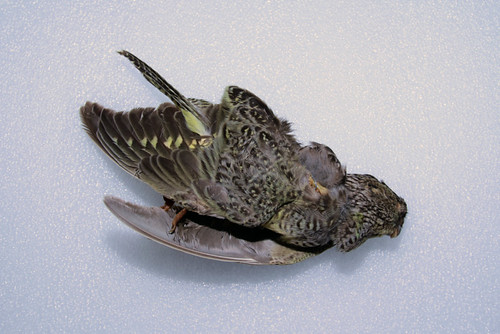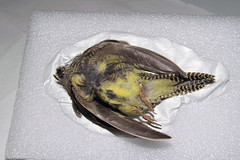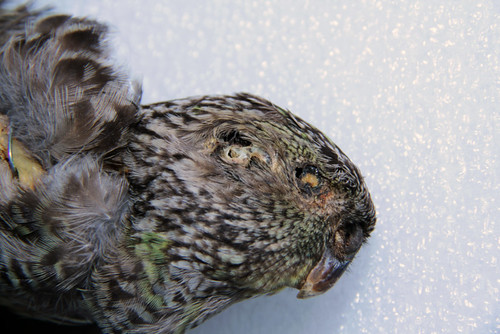Enigmatic and on the edge
 Monday, May 6, 2013 at 5:13
Monday, May 6, 2013 at 5:13  Illustration of the Night Parrot by Philip J Wharton.
Illustration of the Night Parrot by Philip J Wharton.
This is a story that begins with a dead duck and ends with an enigmatic parrot.
The Labrador Duck tipped over the edge into extinction in 1875. This duck is as dead as the dodo. The parrot we can be less definite about.
There is a man who knows a flock of a lot about that ex-duck.
Dr Glen Chilton, ornithologist and behavioural ecologist, made a pilgrimage around the world visiting the relics of the Labrador Duck.
This was a tour of stuffed ducks, dead eggs and defunct breeding sites.
In conversation after his recent Big Ideas interview at Avid Reader, Dr Chilton agreed that his journey was a secular pilgrimage.
His book, The Curse of the Labrador Duck, presents all the stations of the duck.
The grand purpose of the pilgrimage was to visit every authentic relic of the defunct duck.
There were fake ducks, fraudulent fowl, and fabrications such as the the authentic beak stuck onto the painted body of the white domestic duck.
The remaining authentic specimens, as befitting relics, are precious.
All are kept securely and are not on public display. As Dr Chilton says: “Labrador Ducks – they’re not making them anymore.”
In Australia, with our sorry list of extinctions and upcoming terminations there is a bird that although almost absent sparks imagination and hope.
Filmmaker Rob Nugent says that this bird, “only exists in inference.” Yet it seems that they may still be making them.
 The night parrot, little bigger than a budgie, which was found dead in the 1990s in Boulia. Specimen courtesy of Queensland Museum. Image by: Ursula Skjonnemand.
The night parrot, little bigger than a budgie, which was found dead in the 1990s in Boulia. Specimen courtesy of Queensland Museum. Image by: Ursula Skjonnemand.
This is the enigmatic parrot. This is Pezoporus occidentalis – Australia’s Night Parrot.
The last confirmed living specimen was recorded in Western Australia in 1912. It was shot and skinned.
There were no sightings for 75 years after that. In the immortal words of Monty Python it could be said, “THIS IS AN EX-PARROT!!”.
Then two sightings in the last 20 years – sadly both as dead as a stuffed Labrador Duck.
 The night parrot which was found decapitated in 2006. Specimen courtesy of Queensland Museum. Image by: Ursula Skjonnemand.
The night parrot which was found decapitated in 2006. Specimen courtesy of Queensland Museum. Image by: Ursula Skjonnemand.
The 2006 find had been only recently decapitated by a barbed wire fence.
But no live sightings for a long time. And so the myth-making grew.
It has never been photographed; it’s listed by the Smithsonian Institution as one of the five most mysterious birds in the world; it is as Rob Nugent says, “a spectre”.
As with all good myths there are attendant anecdotes.
There’s the one that flew into the cabin of a truck in 1975 – reportedly captured but apparently escaped.
There’s the tragic report of two live specimens left in the kitchen and eaten by a cat.
Then a long emptiness – a few near mythical tales from unreliable sources.
The next sighting in 1990 in Boulia was roadkill.
And then a headless Night Parrot is conjured up in the Diamantina National Park by a grader driver in 2006.
In a recent ABC interview, Rob Nugent and Julian Reid, an ecologist, reported that pilgrimages by birdwatchers, filmmakers and ecologists are made to sites of sightings.
It is all very mysterious. It’s also compelling.
Clearly something which requires the most exacting exercise of the scientific imagination is at work with Rob and Julian.
 The face of a night parrot specimen, which was found dead in Boulia in 1990. Specimen courtesy of Queensland Museum. Image by: Ursula Skjonnemand.
The face of a night parrot specimen, which was found dead in Boulia in 1990. Specimen courtesy of Queensland Museum. Image by: Ursula Skjonnemand.
They are questing through inland Australia, most recently the country around Alice Springs, to make a film about a bird that is/was apparently extinct.
Dr Chilton’s next book is about apparent extinctions.
He says: “There have been more rediscovered species in Australia than anywhere else”.
Hopefully the Night Parrot is a perfectly qualified candidate for the book.
The mythological Night Parrot may be mysterious, alluring and romantic but won’t it be marvelous if “palpable evidence” of its existence animates the enigma?
For more information on dead ducks and enigmatic parrots
Rob and Julian’s Night Parrot stories on Facebook:
http://www.facebook.com/NightParrotStories
These are the stuffed specimens described in Glen Chilton’s book:

